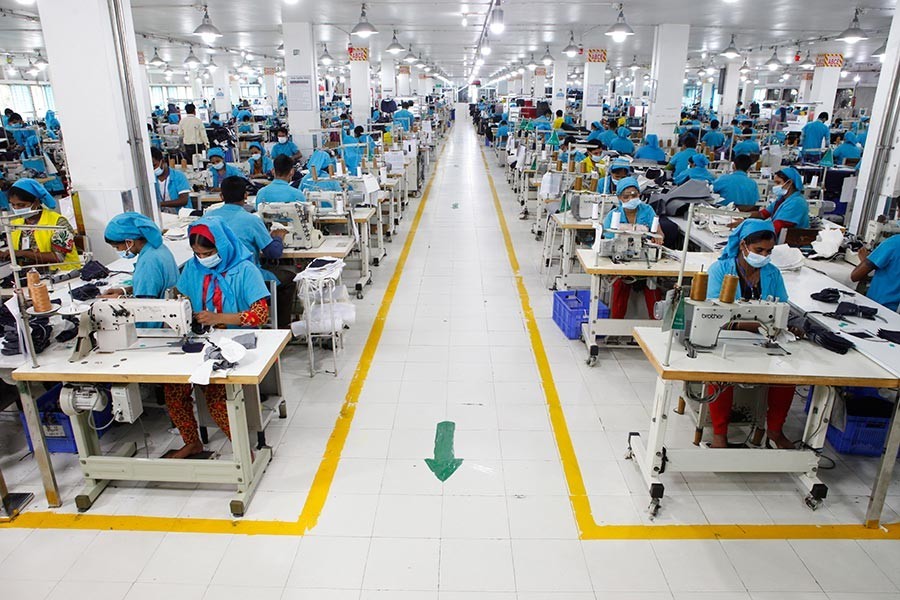
Published :
Updated :

Garment workers, the foot soldiers of Bangladesh's economic success, have finally received some attention from the global community over the last few years thanks to their unsafe working conditions, low wages and benefits, and insufficient amenities at their factories. Worker empowerment initiatives improve worker health, safety, and well-being and research evidence from many formal sector industries across the world has verified this. Empowering workers through operational joint health and safety (H & S) committees and having an effective hazard reporting mechanism are two key and proven ways to improve occupational health and safety. Successful worker empowerment programmes often include the formation of functional workplace H & S committees, offering safety training for the committee members as well as offering awareness training for general workers, and creating a mechanism for workers to report on safety and health concerns and issues at their workplace.
The joint H & S committee plays an important role in occupational health and safety programmes at a workplace, giving workers and employers a platform to collaborate to identify and find solutions to health and safety issues. This can be a good way to improve working conditions and protect workers from injuries and illnesses in Bangladesh. These committees consist of worker and employer representatives and they work together to identify, classify and resolve health and safety problems. The main purpose of the H & S committees is to facilitate communication on occupational health and safety issues.
An effective H & S committee lessens losses associated with injuries and illness. Communication is the key to an effective health and safety system in a workplace. The committee provides a link between the people working on the floor and the people directing it. This brings together a diverse and broad range of expertise and experience to identify hazards and find solutions. Committees bring H & S issues out to have these discussed and resolved. The improved communication reduces accidents, injuries, and illness, increases production, and contributes to developing a culture of teamwork in the workplace.
In Canada, if a workplace has 20 or more workers, it must have a joint H & S committee. If the workplace has between 9 to fewer than 20 workers, it needs to have a worker H & S representative. At least half of the committee members must be workers who do not have any managerial responsibilities, and they are selected by the workers themselves or their union.
The Labour (Amendment) Act 2013 of Bangladesh makes several amendments to the existing Labour Act 2006 to improve workplace safety. It now requires the creation of safety committees in factories with over 50 workers, the establishment of workplace Health Centres in factories with more than 5000 workers, and safety welfare officers in factories with over 500 workers. The government's labour inspectorate is given responsibilities to inspect the safety and health conditions of workplaces as well as conduct on-the-spot inspections. Some other important amendments deal with dangerous work for children, emergency exits, access to stairs for workers, mandatory use of personal safety equipment, notification of competent authority in case of an incident, etc. These are all positive changes when implemented and when functioning H & S committees oversee these practices.
The joint H & S committee helps to identify, eliminate, or control workplace hazards and usually has the following functions:
dentify unhealthy or unsafe situations for workers, and suggest an effective response
Take action to worker complaints relating to health and safety issues
Confer with workers and the employer on occupational health and safety issues, and the working environment
Recommend to the employer on educational programmes promoting health and safety of workers that are in compliance with the Bangladesh Labour Act
Advise the employer on programmes and policies required under the Bangladesh Labour Act, and monitor their effectiveness
Advise the employer on changes to equipment and machinery, or the work processes that improve health or safety of workers
Ensure that accident and dangerous occurrence investigations and regular inspections are carried out as required
Establish and promote health and safety programmes, policies, and training
Investigate worker's refusals to work
With an effective H & S committee at the workplace:
- Accidents are decreased
- Awareness of H & S is created and enhanced
- A wide range of expertise and experience is made available to solve problems
- Co-operation is better through regular communication
- All workers find a way to express concerns and address those.
Western retailers, the Bangladesh government, donor countries and agencies, national and international NGOs, workers' rights advocates, and consumer groups must provide more resources and technical support to help improve the overall health and safety status of garment workers. These worker empowerment initiatives will increase workers' satisfaction, improve their morale, decrease worker absenteeism and turnover, and improve worker productivity and all of these will make this sector in Bangladesh more competitive in the global market.
Dr Hasnat M Alamgir is Professor and Chair of Public Health at IUBAT- International University of Business Agriculture and Technology, Dhaka.


 For all latest news, follow The Financial Express Google News channel.
For all latest news, follow The Financial Express Google News channel.